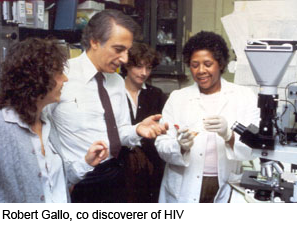
Human immunodeficiency virus infection / Acquired immunodeficiency syndrome (HIV/AIDS) is a disease that affects the human immune system caused by HIV. The illness compromises the immune system, making people with AIDS much more likely the to get opportunistic infections and tumors that people with working immune systems would not usually get. As the disease gets worse the probability and severity of infections increases.
HIV is most commonly transmitted through sexual intercourse (including oral and anal sex), contaminated needles, contaminated blood transfusions, and from mother to child. Prevention of the HIV infection is primarily done through safe sex and needle exchange programs. There is currently no known cure or vaccine against the disease, but antiretroviral treatment can help to slow down the disease. HIV/AIDS is a major health problem in many parts of the world and is considered a pandemic for it is actively spreading The World Health Organization estimated in 2009 that there are 33.4 million people in the world living with HIV.AIDS, resulting in approximately 2 million deaths per year.
Stages and Symptoms
There are three stages of the HIV infection: acute infection, latency and AIDS.
Acute infection usually lasts for several weeks and includes symptoms such as fever, sore throat, rash, muscle aches, chronic fatigue and mouth sores. The latency stage usually involves very few or no symptoms and can last from 2 weeks to 20 years. AIDS is the final stage of the HIV infection and is defined by a low CD4+T cell counts, various opportunistic infections and cancers.
Prevention
Consistent condom use can reduce one’s risk of HIV transmission by approximately 80% over the long-term. Programs such as clean needle exchanges have also proven to be a positive step in preventing one’s risk of HIV transmission. In order to prevent transmission of HIV from mother to child, antivirals are used as well as bottle feeding rather than breast feeding. There is also post exposure which can reduce the risk of HIV after a subsequent needle stick or after sexual assault in which the perpetrator is known to be HIV positive. This involves a course of antiretrovirals that are administered within 48- 72 hours after exposure to HIV positive blood or genital secretions.
Treatment
There is currently no effective HIV vaccine or cure for AIDS, but there is treatment available that can help to strengthen one’s immune system. Currently the best treatment is prevention which can be taught through education.
Antiretroviral Therapy
HIV is what is known as a retrovirus. The HIV virus spreads in a person’s body by invading healthy immune system cells and then making copies of itself to invade more cells. The drugs that are used in HIV treatment are called antiretroviral therapies (ART). They work to control this retrovirus by interfering with the process HIV invading the healthy cells and multiplying.
ART can successfully keep the virus under control for years, but there is currently no cure for HIV. Once you start ART, you must take medication for the rest of your life.
The current recommended HIV treatment involves a combination of these medications, because the virus can become resistant to this therapy if just one drug is used. This multiple drug treatment is called highly active antiretroviral therapy (HAART). If you are on HAART, you will be taking medications from several classes of ART drugs This treatment is very expensive and it may have severe side effects in some people. Once this treatment is started the patient will have to be on it for the rest of your life.